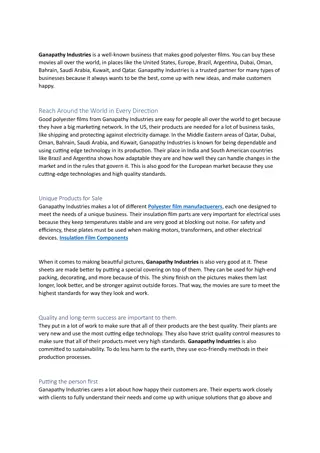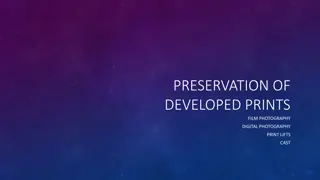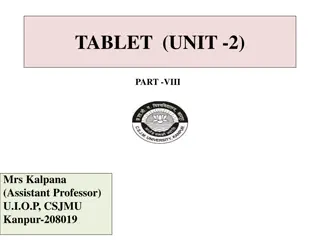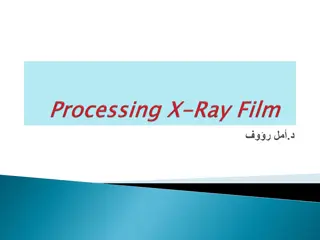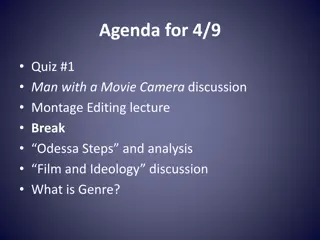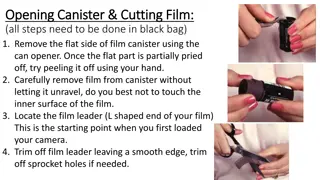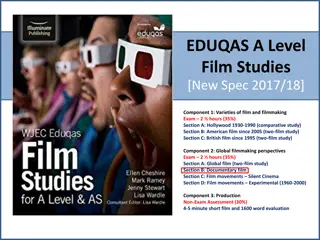Understanding and Applying Assessment Criteria in Film Studies
Ensuring objectivity in assessing students' responses is crucial in film studies. Differentiate between formative and summative assessments for a comprehensive evaluation of student understanding. Understand assessment criteria to accurately evaluate objective knowledge and exercise academic judgment in marking schemes. Assess responses based on identified bands and consider the quality of content covered. Reward the use of appropriate subject terminology within the marking criteria to promote accurate assessment.
Download Presentation

Please find below an Image/Link to download the presentation.
The content on the website is provided AS IS for your information and personal use only. It may not be sold, licensed, or shared on other websites without obtaining consent from the author. Download presentation by click this link. If you encounter any issues during the download, it is possible that the publisher has removed the file from their server.
E N D
Presentation Transcript
Assessing WJEC Eduqas AS Film Studies
Assessing evidence It is important to ensure objectivity in assessing students responses, both at the initial marking stage and during internal standardisation. Do not allow personal knowledge of individual students to affect assessment decisions: ensure that you mark the student responses in front of you rather than the students behind them. JCQ has provided training on ensuring objectivity when assessing students evidence. You should also consider the purpose of the assessment, particularly if you are selecting evidence which has been completed earlier in the course. Formative assessment, conducted during the course of the learning in order to gauge student understanding, may not always provide appropriate evidence, as the student may not have fully developed their understanding of all concepts to the best of their ability at this point in time. Summative assessment, either at the end of the course or the end of a component, may provide a more realistic picture of the students attainment levels.
Assessing evidence Understanding the assessment criteria Assessment criteria generally take two forms: objective marking generally for low tariff responses, where knowledge of objective information is being assessed the exercising of academic judgement via indicative content, that is, an indication of the kind of content responses may include.
Assessing evidence Understanding the assessment criteria objective marking For questions assessing objective knowledge, the assessment criteria should be applied precisely. Marks should be awarded as indicated and no further subdivision made. Where the assessment criteria list points which may be included in students' answers, the list is not exhaustive and teachers should credit valid alternative responses which are not listed. In general, credit should be given according to the accuracy and relevance of students answers.
Assessing evidence Understanding the assessment criteria exercising academic judgement through levels of response mark schemes Firstly, identify the appropriate band a student s response falls into according to the criteria. Award a band where the student s response covers the majority of the criteria. Secondly, consider a mark in the centre of the band and then increase or decrease the mark depending on the quality of the answer, which may be reflected in the amount of indicative content covered. If a response falls between two bands, consider whether there are more characteristics of the higher or lower of the two bands and award accordingly. Indicative content is not exhaustive and other valid responses may be credited. Use of appropriate subject terminology is rewarded within the marking criteria.
Assessing evidence Rubric infringements Nature of Infringement Guidance Not answering the focus of the question set Mark on merit and award appropriate band. Depending on the severity of the lack of focus it may be Band 2 'Basic' or even Band 1 'Limited'. Escalate to Team Leader if unsure. Zero marks awarded. Inappropriate film -Answering using texts that are not set by the WJEC specification or from other parts of the specification. Answering on one film in a two film study Unbalanced response (refers to one film over another film in a two film study or comparison) Divide mark by two. Mark within the appropriate band for example, if there is Excellent/Band 5 understanding of one film and Basic/Band 2 of the other then a top Band 3 or lower Band 4 may be the best fit approach. If you are unsure wether the reference to the second film is worthy of credit, escalate to Team Leader.
Assessing evidence Rubric infringements Nature of Infringement Guidance No sequence referenced or identified in a sequence question Award up to Top Band 3 depending on the understanding demonstrated by the response. One sequence referred to in a two film study or comparison sequence question Award up to Top Band 4 depending on the understanding demonstrated by the response. Confused context i.e. talks about 'production' in a 'social' context question There are some overlaps of contexts. Mark on merit and put in correct band according to the knowledge and understanding demonstrated. Uses two films from same group Divide mark by two. No comparison in a comparative study No marks awarded for A02
Assessing evidence Assessment Purpose Component 1 (Varieties of film and filmmaking) examines A01 and A02 in relation to Hollywood 1930-1990 and Contemporary American Independent film. These assessment objectives carry equal weighting in determining the mark scheme bands and numerical marks for responses to each section. Throughout Component 1, learners must demonstrate knowledge and understanding of the Core Study Areas and related Specialist Study Areas (AO1) as well as apply (AO2) that knowledge and understanding according to the requirements of the question. The Core Study Areas are: Film Form Meanings and Responses The Contexts of Film The Specialist Study Areas related to Component 1 sections are: Section A Auteur Section B Spectatorship
Assessing evidence Assessment Criteria Amplifying the Assessment Objectives Below are the assessment objectives for Component 1 and some suggested amplifications of each one to help explain how we might see these evidenced in various student responses to different questions. Delineations of assessment objectives will be dependent upon the question set and will be indicative of differentiated responses. This is not an exhaustive list, there are other ways of demonstrating or applying knowledge and understanding. AO1 - Demonstrate knowledge and understanding of elements of film Selection of specific key elements of film form within the films studied and the ability to use subject-specific terminology to identify these elements. Identification of significant contexts that may have shaped and influenced the films studied. Identifying meanings and responses that are relevant to the films studied. Identification of relevant aspects of auteur study and spectatorship in relation to the films studied. Recall accurate facts in relation to the films studied and their contexts. Describe and explain elements of film in relation to the question set. Select significant elements of film in response to the question. Explain elements of film in relation to the films studied.
Assessing evidence Assessment Criteria Amplifying the Assessment Objectives Below are the assessment objectives for Component 1 and some suggested amplifications of each one to help explain how we might see these evidenced in various student responses to different questions. Delineations of assessment objectives will be dependent upon the question set and will be indicative of differentiated responses. This is not an exhaustive list, there are other ways of demonstrating or applying knowledge and understanding AO2 - Apply knowledge and understanding of elements of film to: analyse and compare films The ability to link elements of film form to meanings and responses in specific and relevant ways. The ability to find points of comparison between two films in relation to context, core or auteur areas of study Organising knowledge to form a coherent and persuasive answer to the question set. The ability to identify similarities and differences between the films studied and the ability to account for these. The ability to support and exemplify an argument with well selected evidence. The ability to provide detailed sequence analysis using appropriate film studies terminology
Assessing evidence Assessment Criteria Amplifying the Mark Scheme Bands: General Information Marking should be positive, rewarding achievement rather than penalising failure or omissions. The awarding of marks must be directly related to the marking criteria. Examiners should use the generic assessment grid and the indicative content for each question when assessing a candidate s response. Band Descriptors When awarding a mark, examiners should select the band that most closely describes the quality of the work being assessed. Marking grids, which include guidance on how to allocate marks within bands, have been constructed using the principles below. Once the appropriate band has been selected, examiners should award in the notional centre of the band, awarding higher or lower depending on the strength of the response. Where the candidate's work securely meets the descriptors, award marks in the notional centre of a band and then adjust higher or lower depending on the degree to which the band's criteria are met. Where the candidate s work convincingly meets the descriptors, the highest mark should be awarded, depending on the strength of the answer Where the candidate s work less securely meets the descriptors, the lowest mark should be awarded, depending on the degree of its weaknesses. Where a candidate's work combines the qualities of two different bands, examiners should use their professional judgement to award a mark in the band which best describes the majority of the candidate's work. Where there is a two-mark range within each band, examiners should award: the upper of the two marks for work which convincingly meets the descriptors or the lower of the two marks for work which less strongly meets the descriptors. Assessors should use the full range of marks available to them.
Assessing evidence Understanding the Assessment Bands: Band 5: Excellent MEANS detailed film analysis, concise & focused answers question, confident use of terminology, consistent display of knowledge and understanding of elements of film Band 4: Good MEANS reasonably detailed analysis, focused on question, good use of terminology, displays regular knowledge and understanding of elements of film Band 3: Satisfactory MEANS some key points of analysis, focuses on question, some use of terminology, knowledge and understanding of elements of film is evident Band 2: Basic MEANS vague or descriptive points of analysis with some relevance to question, knowledge and understanding is straightforward or common-sense Band 1: Limited MEANS little analysis, little or no knowledge and understanding, short, incomplete or barely attempted
Assessing evidence Characteristics of a successful response in Section A Explicit comparisons are made between the films studied that show accurate and detailed knowledge and understanding. In the best responses, comparisons are incisive and very well selected to develop a sophisticated and engaging response. Demonstrates detailed, comprehensive knowledge and a fluent understanding of auteur debates (if relevant to question). In the best responses, wider contextual knowledge and a very sophisticated understanding of auteurism is shown (where relevant to question). Knowledge and understanding of contextual factors is detailed and clearly linked to analysis and comparison of the films. There is a confident knowledge and understanding of meanings and responses in relation to the chosen films shown. Applies knowledge and understanding to produce relevant, confident and detailed analysis of the films studied. Identification of key elements of film form are accurate and clearly linked to meanings and responses. Uses subject terminology fluently and with precision to analyse and compare the chosen films. Engages with the question clearly and provides a sustained, detailed answer. Writes about both films equally, overall, and does not produce a partial, unbalanced response to one of the films. See OER Q1.3, Example 1
Assessing evidence Characteristics of a less successful response in Section A Comparisons made between the films studied are simplistic, minimal or only implicit and will show partial or basic knowledge and understanding. Demonstrates very little knowledge and a weak understanding of the concept tested by the question The response will struggle to make relevant links to the films studied beyond a few points stated and undeveloped. Demonstrates basic, incomplete knowledge and a limited understanding of core study areas, relevant to the films studied and the question set. Knowledge and understanding of contextual factors is minimal and may be lacking. Links between contextual factors and analysis or comparison of the films will be sparse and stated rather than developed. Tends toward description rather than analysis of the films studied. Identification of key elements of film form may be inaccurate, generalised and simplistically linked to meanings and responses. Use of subject terminology may be minimal, basic and inaccurate. Engagement with the question may be rather superficial, lack detail and partial. Responses are likely to be stated rather than supported and discussed. Will write about at least one of the films in a very brief, undeveloped manner or, perhaps, not at all. See OER Q1.3, Example 2
Assessing evidence Characteristics of a successful response in Section B Apply these points in relation to the concept being tested by the question (Spectatorship/Core Areas) Demonstrates detailed, comprehensive knowledge and a fluent understanding of specialist study concept tested by the question In the best responses, wider knowledge and a very sophisticated understanding of the complexities of Spectatorship/Core areas and the films studied is shown (when relevant to the question). In the best responses, a cautious and thoughtful approach to the interaction of film and spectator will be shown and a sophisticated application of Spectatorship (when tested) is evident. Demonstrates detailed, accurate knowledge and understanding of core study areas, relevant to the films studied and the question set. There is a confident knowledge and understanding of meanings and responses in relation to the films studied. Applies knowledge and understanding to produce relevant, confident and detailed analysis of the films studied. Identification of key elements of film form is accurate and clearly linked to meanings and responses. Uses subject terminology fluently and with precision to analyse and compare the chosen films. Engages with the question clearly and provides a sustained, detailed answer. Writes about both films equally, overall, and does not produce a partial, unbalanced response to one of the films. See OER Q2.1, Example 1
Assessing evidence Characteristics of a less successful response in Section B Apply these points in relation to the concept being tested by the question (Spectatorship/Core Areas) Demonstrates a partial or undeveloped knowledge and understanding of Spectatorship/Core areas in relation to the films studied. Analysis of films studied may be stated rather than explored or supported with evidence. Demonstrates partial knowledge and understanding of Spectatorship/Core areas and may struggle to make this relevant to the films studied. Responses will be stated without caution and assumed rather than discussed and explained. Demonstrates basic, incomplete knowledge and a limited understanding of core study areas, relevant to the films studied and the question set. Knowledge and understanding of contextual factors (where appropriate) is minimal and may be lacking. Links between contextual factors and analysis of the films will be sparse and stated rather than developed. Tends toward description rather than analysis of the films studied. Identification of the key elements of film form may be inaccurate, generalised and simplistically linked to meanings and responses. Use of subject terminology may be minimal, basic or inaccurate. Engagement with the question may be rather superficial, lack detail and partial. Responses are likely to be stated rather than supported and discussed. Will write about at least one of the films in a very brief, undeveloped manner or, perhaps, not at all. See OER Q2.3, Example 1
Assessing evidence Potential Issues and how to assess: If responses seem to use no comparison in Section A, check carefully. Comparison may be implicit so can still have some credit but if absolutely no comparison is present, no marks for AO2 can be awarded and only a maximum of 20 marks for AO1 can be. If only one film is referenced, no comparison can be be present and therefore no AO2 mark can be given. See full Rubric issues guide above
Assessing evidence Assessment Purpose Component 2 (Varieties of film and filmmaking) examines A01 and A02 in relation to British Film and European Film. These assessment objectives carry equal weighting in determining the mark scheme bands and numerical marks for responses to each section. Throughout Component 2, learners must demonstrate knowledge and understanding of the Core Study Areas and related Specialist Study Areas (AO1) as well as apply (AO2) that knowledge and understanding according to the requirements of the question. The Core Study Areas are: Film Form Meanings and Responses The Contexts of Film The Specialist Study Areas related to Component 2 sections are: Section A Narrative (including critical approaches) Section B Core Study Areas
Assessing evidence Assessment Criteria Amplifying the Assessment Objectives Below are the assessment objectives for Component 2 and some suggested amplifications of each one to help explain how we might see these evidenced in various student responses to different questions. Delineations of assessment objectives will be dependent upon the question set and will be indicative of differentiated responses. This is not an exhaustive list, there are other ways of demonstrating or applying knowledge and understanding. AO1 - Demonstrate knowledge and understanding of elements of film Selection of specific key elements of film form within the films studied and the ability to use subject-specific terminology to identify these elements. Identification of significant contexts that may have shaped and influenced the films studied. Identifying meanings and responses that are relevant to the films studied. Identification of relevant aspects of narrative in relation to the films studied. Recall accurate facts in relation to the films studied and their contexts. Describe and explain elements of film in relation to the question set. Select significant elements of film in response to the question. Explain elements of film in relation to the films studied.
Assessing evidence Assessment Criteria Amplifying the Assessment Objectives Below are the assessment objectives for Component 2 and some suggested amplifications of each one to help explain how we might see these evidenced in various student responses to different questions. Delineations of assessment objectives will be dependent upon the question set and will be indicative of differentiated responses. This is not an exhaustive list, there are other ways of demonstrating or applying knowledge and understanding AO2 - Apply knowledge and understanding of elements of film including the use of critical approaches The ability to link elements of film form to meanings and responses in specific and relevant ways. The ability to explore the films studied through the application of a critical approach Organising knowledge to form a coherent answer to the question set. The ability to support and exemplify an argument with well selected evidence. The ability to provide detailed sequence analysis using appropriate film studies terminology
Assessing evidence Assessment Criteria Amplifying the Mark Scheme Bands: General Information Marking should be positive, rewarding achievement rather than penalising failure or omissions. The awarding of marks must be directly related to the marking criteria. Examiners should use the generic assessment grid and the indicative content for each question when assessing a candidate s response. Band Descriptors When awarding a mark, examiners should select the band that most closely describes the quality of the work being assessed. Marking grids, which include guidance on how to allocate marks within bands, have been constructed using the principles below. Once the appropriate band has been selected, examiners should award in the notional centre of the band, awarding higher or lower depending on the strength of the response. Where the candidate's work securely meets the descriptors, award marks in the notional centre of a band and then adjust higher or lower depending on the degree to which the band's criteria are met. Where the candidate s work convincingly meets the descriptors, the highest mark should be awarded, depending on the strength of the answer Where the candidate s work less securely meets the descriptors, the lowest mark should be awarded, depending on the degree of its weaknesses. Where a candidate's work combines the qualities of two different bands, examiners should use their professional judgement to award a mark in the band which best describes the majority of the candidate's work. Where there is a two-mark range within each band, examiners should award: the upper of the two marks for work which convincingly meets the descriptors or the lower of the two marks for work which less strongly meets the descriptors. Assessors should use the full range of marks available to them.
Assessing evidence Understanding the Assessment Bands: Band 5: Excellent MEANS detailed film analysis, concise & focused answers question, confident use of terminology, consistent display of knowledge and understanding of elements of film Band 4: Good MEANS reasonably detailed analysis, focused on question, good use of terminology, displays regular knowledge and understanding of elements of film Band 3: Satisfactory MEANS some key points of analysis, focuses on question, some use of terminology, knowledge and understanding of elements of film is evident Band 2: Basic MEANS vague or descriptive points of analysis with some relevance to question, knowledge and understanding is straightforward or common-sense Band 1: Limited MEANS little analysis, little or no knowledge and understanding, short, incomplete or barely attempted
Assessing evidence Characteristics of a successful response in Section A Demonstrates detailed, comprehensive knowledge and a fluent understanding of auteur debates (if relevant to question). In the best responses, wider contextual knowledge and a very sophisticated understanding of narrative is shown (where relevant to question). Well selected examples from the films studied support a sophisticated and engaging response. Demonstrates detailed, accurate knowledge and a fluent understanding of core study areas, relevant to the films studied and the question set. Knowledge and understanding of narrative is detailed and clearly linked to analysis of the films studied. There is a confident knowledge and understanding of meanings and responses in relation to the chosen films shown. Applies knowledge and understanding to produce relevant, confident and detailed analysis of the films studied. Identification of key elements of film form are accurate and clearly linked to meanings and responses. Uses subject terminology fluently and with precision to analyse the films studied. Engages with the question clearly and provides a sustained, detailed answer. Writes about both films equally, overall, and does not produce a partial, unbalanced response to one of the films. See OER Q1.2, Example 1
Assessing evidence Characteristics of a less successful response in Section A Comparisons made between the films studied are simplistic, minimal or only implicit and will show partial or basic knowledge and understanding. Demonstrates very little knowledge and a weak understanding of the concept tested by the question The response will struggle to make relevant links to the films studied beyond a few points stated and undeveloped. Demonstrates basic, incomplete knowledge and a limited understanding of core study areas, relevant to the films studied and the question set. Knowledge and understanding of contextual factors is minimal and may be lacking. Links between contextual factors and analysis or comparison of the films will be sparse and stated rather than developed. Tends toward description rather than analysis of the films studied. Identification of key elements of film form may be inaccurate, generalised and simplistically linked to meanings and responses. Use of subject terminology may be minimal, basic and inaccurate. Engagement with the question may be rather superficial, lack detail and partial. Responses are likely to be stated rather than supported and discussed. Will write about at least one of the films in a very brief, undeveloped manner or, perhaps, not at all. See OER Q1.3, Example 2
Assessing evidence Characteristics of a successful response in Section B Apply these points in relation to the concept being tested by the question (Core Areas) Demonstrates detailed, comprehensive knowledge and a fluent understanding of the core area of study being tested by the question In the best responses, wider knowledge and a very sophisticated understanding of the complexities of the core areas of study in relation to meaning and response in the films studied is shown. Demonstrates detailed, accurate knowledge and a fluent understanding of core study areas, relevant to the films studied and the question set. Provides detailed and sophisticated sequence analysis. There is a confident knowledge and understanding of meaning and responses in relation to the films studied. Applies knowledge and understanding to produce relevant, confident and detailed analysis of the films studied. Identification of key elements of film form is accurate and clearly linked to meanings and responses. Uses subject terminology fluently and with precision to analyse and compare the chosen films. Engages with the question clearly and provides a sustained, detailed answer. Writes about both films equally, overall, and does not produce a partial, unbalanced response to one of the films. See OER Q2.3, Example 1
Assessing evidence Characteristics of a less successful response in Section B Apply these points in relation to the concept being tested by the question (Core Areas) Demonstrates a partial or undeveloped knowledge and understanding of the core areas in relation to the films studied. Analysis of films studied may be stated rather than explored or supported with evidence. Demonstrates partial knowledge and understanding of the core areas and may struggle to make this relevant to the films studied. Responses will be stated without caution and assumed rather than discussed and explained. Demonstrates basic, incomplete knowledge and a limited understanding of core study areas, relevant to the films studied and the question set. Knowledge and understanding of contextual factors (where appropriate) is minimal and may be lacking. Tends toward description rather than analysis of the films studied. Identification of the key elements of film form may be inaccurate, generalised and simplistically linked to meanings and responses. Use of subject terminology may be minimal, basic or inaccurate. Engagement with the question may be rather superficial, lack detail and partial. Responses are likely to be stated rather than supported and discussed. Will write about at least one of the films in a very brief, undeveloped manner or, perhaps, not at all. See OER Q2.2, Example 2
Assessing evidence Potential Issues and how to assess: Note that no comparison is required in either Section. Candidate should make detailed reference to two films but this does not have be equal reference. See full Rubric issues guide above
Any Questions? If you have any questions, contact our specialist subject officers and administrative support team for your subject with any queries. film@eduqas.co.uk











